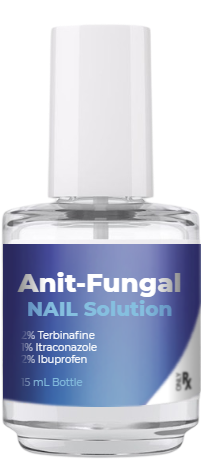Product Breakdown
Terbinafine
Terbinafine is an oral and topical antifungal agent that is pharmacologically similar to naftifine. Oral terbinafine is highly effective for treating onychomycosis due to its fungicidal activity and ability to concentrate within the nail. In clinical studies, the efficacy of oral terbinafine in the treatment of onychomycosis was found to be superior to both griseofulvin [1][2] and itraconazole.[3] Further, the rate of relapse with terbinafine were lower than those observed with griseofulvin.[1] Onychomycosis clinical cure rates for terbinafine are approximately 50% to 70%. Oral terbinafine has also been utilized in small open-label studies as an alternative treatment for bronchopulmonary aspergillosis refractory to other treatments; in some cases terbinafine has suppressed or eradicated the disease. Topical terbinafine was approved by the FDA in 1993. Terbinafine oral tablets were approved May 1996. Terbinafine cream received approval as an over-the-counter treatment of tinea pedis in March 1999. Terbinafine oral granules were approved for use in pediatric patients, ages 4 years and older, for the treatment of tinea capitis in September 2007.
Itraconazole
Itraconazole is an oral azole antifungal agent indicated for the treatment of pulmonary and extrapulmonary blastomycosis, histoplasmosis, including chronic cavitary pulmonary disease and disseminated, nonmeningeal disease, pulmonary and extrapulmonary aspergillosis in patients who are intolerant or refractory to amphotericin B, onychomycosis of the toenail or fingernail in non-immunocompromised patients, and oropharyngeal or esophageal candidiasis. FDA-approved indications vary by dosage form, and dosage forms are not interchangeable. Itraconazole is closely related to ketoconazole but appears to have fewer adverse effects. Itraconazole is active against many of the same fungi as ketoconazole and fluconazole but has greater activity against Aspergillus.
Ibuprofen
Ibuprofen is a nonsteroidal anti-inflammatory drug (NSAID) of the propionic acid chemical class. Ibuprofen is a racemic mixture of 2 isomers; however, only the l-isomer of ibuprofen has been shown to have clinical activity. Although d-isomer is considered inactive, it is slowly and incompletely converted to the l-isomer in adults and probably children and may serve as a circulating reservoir for the active drug. All NSAIDs carry an increased risk of serious gastrointestinal adverse effects including bleeding, ulceration, and perforation of the stomach or intestines and may cause an increased risk of serious cardiovascular (CV) thrombotic events, myocardial infarction, and stroke. FDA approved labeling of both the OTC and prescription products stress dosing at the lowest effective ibuprofen dose for the shortest possible duration, as the risk for adverse effects may increase with increased use. A retrospective review by FDA Advisory Committees of short-term efficacy trials of a related non-prescription strength NSAID indicated that an increase in CV events was not apparent during the studies. However, it is important to note that CV risk was not the focus of the studies, and further information is needed to determine if a cause and effect relationship exists between non-prescription strength NSAID use and adverse cardiovascular outcomes. Specific populations are at an increased risk of NSAID-induced adverse events. The American Geriatrics Society recommends that NSAIDs (nonselective and COX-2 inhibitors) not be used to treat persistent pain in elderly patients except rarely, then only in patients who have failed other therapies and have a favorable benefits vs risks assessment; extreme caution, continued therapy evaluation, and concurrent PPI or misoprostol is advised with ibuprofen use in this population. Ibuprofen is indicated for the treatment of rheumatoid arthritis, osteoarthritis, and dysmenorrhea. It also is used for its antipyretic effects and for the alleviation of mild to moderate pain. In addition, clinical studies have demonstrated its effectiveness in the treatment of ankylosing spondylitis, gout, and psoriatic arthritis. Topical use has been studied in minor muscle pain treatment. See separate ibuprofen lysine monograph for discussion of NeoProfen, the intravenous formulation indicated to close a clinically significant patent ductus arteriosus in premature infants. Oral ibuprofen was approved by the FDA in 1974.
Storage
Store this medication at 68°F to 77°F (20°C to 25°C) and away from heat, moisture and light. Keep all medicine out of the reach of children. Throw away any unused medicine after the beyond use date. Do not flush unused medications or pour down a sink or drain.

